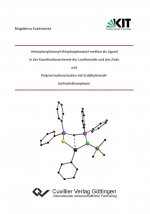
Kód: 12738424
Towards Identifying the Physiological and Molecular Basis of Drought Tolerance in Cassava (Manihot esculenta Crantz)
Autor Rosemary Wanja Mutegi-Murori
Drought is one of the most important factors limiting crop production in sub-SaharanAfrica. This has detrimental effects to the people living in this region, and whosepopulation is increasing more rapidly than their domestic food ... celý popis
- Jazyk:
 Angličtina
Angličtina - Vazba: Brožovaná
- Počet stran: 166
Nakladatelství: Cuvillier Verlag, 2010
- Více informací o knize

Mohlo by se vám také líbit
-

Doll in the Garden
254 Kč -

The FBI
771 Kč -

The Autobiography of G.K. Chesterton
394 Kč -

Soldier's Guide
423 Kč -

Preliminary Personal Development, Health and Physical Education
1233 Kč -

Iminophosphoranyl?thiophosphoranyl?methan als Ligand in der Koordinationschemie der Lantha-noide und des Zinks und Polymerisationsstudien mit Erdalkal
537 Kč -

Orgueil et Préjugé
501 Kč
Dárkový poukaz: Radost zaručena
- Darujte poukaz v libovolné hodnotě a my se postaráme o zbytek.
- Poukaz se vztahuje na celou naši nabídku.
- Elektronický poukaz vytisknete z e-mailu a můžete ihned darovat.
- Platnost poukazu je 12 měsíců od data vystavení.
Více informací o knize Towards Identifying the Physiological and Molecular Basis of Drought Tolerance in Cassava (Manihot esculenta Crantz)
Nákupem získáte 71 bodů
 Anotace knihy
Anotace knihy
Drought is one of the most important factors limiting crop production in sub-SaharanAfrica. This has detrimental effects to the people living in this region, and whosepopulation is increasing more rapidly than their domestic food production.Noticeably, pressure on agricultural land has continued to intensify. Cassava is one ofthe staple crops with remarkable tolerance to drought. It is adapted to diverse andpoor soil conditions, in addition to its flexibility in planting and harvesting times.Understanding its physiological and molecular basis of drought tolerance may help totarget the key traits that limit crop yield under drought conditions. To improve ourunderstanding on drought tolerance mechanisms in cassava, the project "Identifyingthe physiological and genetic traits that make cassava one of the most drought-tolerantcrops" was initiated in 2005 by the Brazilian Agricultural Research Corporation(Embrapa) in collaboration with the International Center for Tropical Agriculture(CIAT); the International Institute of Tropical Agriculture (IITA); Cornell Universityand University of Goettingen. The ultimate goal of the project was to identifymorphological, physiological and molecular traits related to drought tolerancemechanisms in cassava for further progress, and for their application in cassava andother crop breeding programs.The present study was conducted within the framework of this project with 31 Africancassava germplasm accessions from IITA and a mapping population developed atCIAT. The objectives of this study were,1) To develop a protocol for hardening and rapid micro-propagation of cassavaplantlets under local, low-cost conditions;2) To identify agro-morphological attributes that are related to drought tolerancein cassava;3) To identify drought-tolerant and drought-susceptible cassava germplasm froma selection of African accessions;4) To identify secondary traits that could be used for phenotyping breedingmaterials for drought tolerance;5) To screen the CIAT mapping population with simple sequence repeats (SSR)and expressed simple sequence repeat (ESSR) markers for linkage analysis.Thirty one putative drought-tolerant and drought-susceptible African cassavagermplasm accessions from IITA were micro-propagated using direct and in-directtechniques, at Kenya Agricultural Research Institute (KARI), Nairobi, Kenya. Indirect micro-propagation, plantlets were hardened using vermiculite and multipliedthrough nodal cuttings. In in-direct micro-propagation, plantlets were first multipliedthrough sub-culturing and later hardened. The direct micro-propagation method had ahigher multiplication rate. The number of plantlets obtained in 7 months using thedirect method were 1173 as compared to 722 attained using the in-direct micropropagation.Rapid micro-propagation through nodal cuttings was cheaper in terms ofconsumables and an effective alternative to enhance rates of multiplication, over thein-direct method and the more conventional technique like the use of stem cuttings.Agronomic and morphological evaluation of contrasting African cassava germplasmaccessions was carried out in water-stressed and well-watered environments at 5 timepoints. The trial was conducted at the experimental field of KARI, Kiboko ResearchStation in Makindu, Eastern Kenya, a site characterized by Acri-orthic Ferralsol soil.Analysis of variance was performed using the agronomic and morphological data, andbroad sense heritability was estimated.In general, significant differences were observed among the accessions, suggesting astrong genetic basis for the phenotypic variation observed. Variation was also notablein water-stressed and well-watered environments for a majority of traits evaluated.This was due to the artificial water applied since, during the trial period, there washardly any rainfall.At harvest, leaf length and width of certain accessions at the water-stressed siteapproached that of the well-watered treatment. On average, the estimated meanpercentage leaf retention was high in the well-watered treatment. However, leafretention in some of the accessions assessed was almost the same in both treatments.These accessions tended to produce higher yields. Thus, it may be desirable to selectfor higher leaf retention when developing varieties adapted to dry areas. The range ofyields under stress was from 3.3 to 36.7 kg/m2, whereas, under the well-wateredtreatment, it was smaller: 28.3 to 53.3 kg/m2. Differences among accessions in yieldand overall above-ground fresh biomass showed that these are important primarytraits to phenotype germplasm under favorable and water-stress conditions. Inaddition, 4 accessions G26, G11, G8 and G31 were more tolerant than the rest of thegenotypes evaluated, calling for further research and their involvement in agriculturalexperimentation under drought-prone conditions.Considering relationships between traits, genotype ability for both accumulation ofabove-ground fresh biomass and to partition carbon into roots (harvest index) wereamong the traits most correlated with root yield. However, accessions, environmentand the interaction of both influenced the traits strongly. Thus, it is important thatagro-morphological field trials be conducted in several locations for several seasonsfor effective evaluation of their influences on traits that might be relevant forphenotypically assessing drought tolerance.Unlike for agro-morphological traits, where a drought-tolerant accession could beidentified from the yield, which is of primary concern, selection of an outstandingaccession in a water-limited environment using metabolic traits was not achieved inthis study. Maybe the well-watered plants experienced an incipient stress due to lowhumidity, symptomless diseases or nutrient deficiency, which was not ascertained inthis study. Despite this, significant differences were observed between the waterstressedand well-watered treatments for the traits evaluated, except protein andamylose content. Performance in individuals was variable, although insignificantdifferences were observed between the different stress phases.Changes in sugar concentration have a role in the drought-tolerance of the accessionsevaluated, although, their relative contribution to drought stress could not bedetermined from the available data. Further work is imperative to identify andquantify sugar concentrations in relation to osmotic adjustment in these accessions. Inaddition, further research to determine the time course of ABA accumulation, as acassava plant goes from its young stage to aging, is required so as to know the stage atwhich ABA data are most informative.Two genetic linkage maps were constructed using a South American mappingpopulation of 228 individuals derived from a cross between a drought-tolerant and adrought-susceptible parent. A set of 377 simple sequence repeats (SSR) and expressedsimple sequence repeats (ESSR's) were utilized for the initial polymorphismscreening. Differences in map size, interval, number and mean distance betweenmarkers were apparent between the two maps. The female map had 14 linkage groupsas compared to 13 in the male map. Twenty seven allelic bridges were noticeablebetween the two maps. In addition, 25 markers showed collineality with otheravailable cassava maps. Forty six markers, whose map distances had not beendetermined previously, were mapped in this study. These maps form an importantplatform upon which to characterize the genetic basis of drought tolerance in cassava.Continued addition of more markers in these maps will refine the utility of theresource for future cassava breeding efforts.In conclusion, four African cassava accessions apparently have the ability towithstand severe drought. However, a majority of the accessions evaluated gave poorresponse in adaptability to water-limited conditions. This suggests that further agroecologicallybased research is required on these materials, since they represent diverseimproved accessions from IITA breeding activities. This, coupled with markerassistedgenetic analysis, would be an appropriate approach for the identification ofdrought-tolerant accessions.
 Parametry knihy
Parametry knihy
707 Kč
- Plný název: Towards Identifying the Physiological and Molecular Basis of Drought Tolerance in Cassava (Manihot esculenta Crantz)
- Autor: Rosemary Wanja Mutegi-Murori
- Jazyk:
 Angličtina
Angličtina - Vazba: Brožovaná
- Počet stran: 166
- EAN: 9783869552606
- ISBN: 3869552603
- ID: 12738424
- Nakladatelství: Cuvillier Verlag
- Hmotnost: 224 g
- Rozměry: 210 × 148 × 9 mm
- Datum vydání: 10. February 2010
Oblíbené z jiného soudku
-

Berserk Deluxe Volume 1
1033 Kč -

Haunting Adeline
617 Kč -

Berserk Deluxe Volume 2
1056 Kč -

Berserk Deluxe Volume 3
1138 Kč -

LEGO Star Wars Visual Dictionary Updated Edition
534 Kč -

Atomic Habits
483 Kč -

White Nights
90 Kč -

Powerless
276 Kč -

Chainsaw Man, Vol. 15
251 Kč -

Harry Potter and the Prisoner of Azkaban (Minalima Edition)
978 Kč -

Berserk Deluxe Volume 5
1115 Kč -

Hunting Adeline
633 Kč -

House of Leaves
405 Kč -

Iron Flame
462 Kč -

Cry Baby Coloring Book
257 Kč -

JUJUTSU KAISEN V22
241 Kč -

The Official Stardew Valley Cookbook
607 Kč -

Gravity Falls Journal 3
427 Kč -

The 48 Laws of Power
523 Kč -

Dune Messiah
178 Kč -

Heaven Official's Blessing: Tian Guan Ci Fu (Novel) Vol. 2
442 Kč -

Dune
254 Kč -

Surrounded by Idiots
256 Kč -

Twisted Love
215 Kč -

Berserk Deluxe Volume 4
1165 Kč -

Twisted Lies
276 Kč -

Berserk Deluxe Volume 6
1086 Kč -

A Little Life
258 Kč -

Heaven Official's Blessing: Tian Guan Ci Fu (Novel) Vol. 1
357 Kč -

Bungo Stray Dogs, Vol. 8 (light novel)
389 Kč -

Twisted Games
214 Kč -

Fourth Wing
214 Kč -

King of Sloth
276 Kč -

CHAINSAW MAN V14
248 Kč -

48 Laws Of Power
471 Kč -

Berserk Deluxe Volume 10
1163 Kč -

The Husky and His White Cat Shizun: Erha He Ta de Bai Mao Shizun (Novel) Vol. 5
373 Kč -

Court of Thorns and Roses Paperback Box Set (5 books)
1113 Kč -

Court of Mist and Fury
254 Kč -

Court of Thorns and Roses
218 Kč -

No Longer Human
330 Kč -

Vagabond (VIZBIG Edition), Vol. 1
641 Kč -

Raising Mentally Strong Kids: How to Combine the Power of Neuroscience with Love and Logic to Grow Confident, Kind, Responsible, and Resilient Child
607 Kč -

Heaven Official's Blessing: Tian Guan Ci Fu Vol. 4
441 Kč -

Twisted Series 4-Book Boxed Set
1064 Kč -

Powerful
265 Kč -

Dead Poets Society
176 Kč -

A Court of Silver Flames
276 Kč -

Throne of Glass Box Set (Paperback)
2146 Kč
Osobní odběr Praha, Brno a 12903 dalších
Copyright ©2008-24 nejlevnejsi-knihy.cz Všechna práva vyhrazenaSoukromíCookies



 Vrácení do měsíce
Vrácení do měsíce 571 999 099 (8-15.30h)
571 999 099 (8-15.30h)